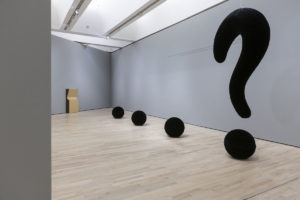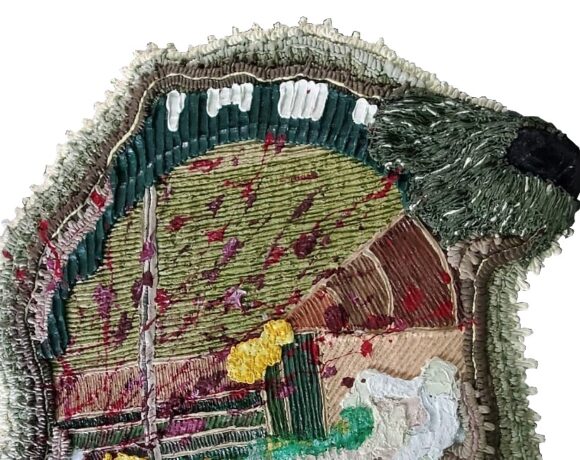Reclaiming the uselessness of art does not mean endorsing the coarse theories of those who are convinced that culture is not useful for eating; on the contrary, it means being aware that, despite the materialistic and functionalist drift that society seems to have taken, man does not need to satisfy only primary needs, but also actions that, while not giving tangible and immediate benefits, allow him to give vent to one’s creative impulses, to the need to freely express oneself, or to the simple desire to stop in contemplation.
The retrospective on Richard Artschwager, an American artist of European origin presented by Mart museum in collaboration with the Guggenheim in Bilbao, seems to underline this important aspect of art. A wide exhibition, the first anthological exhibition in Italy dedicated to the artist who died in 2013, entrusted to an excellent curator and critic such as Germano Celant.
The life of the artist is retraced through a selection of his most important works arranged with maximum freedom, without following slavishly chronological or stylistic criteria. The pieces that first come to the attention are undoubtedly his wooden and plastic laminate structures: installations halfway between works of art and furnishings, the works of Artschwager dilate the sense of doing art, dragging industrial products into the sphere of unique craft. These objects, modified and placed in the museum context, become “useless machines”, destined for nothing else but to be contemplated. Yet the artist’s interdiction to their natural function does not communicate a sense of death and abandonment: on the contrary, subtracted from their obligation to “be used”, they acquire meaning from their own existence, and surrounded by the artistic aura they seem to become monuments of themselves. The skilful installation contributes to generate this effect: each work breathes freely in space, without getting crowded; in this way, each acquires a prominent position in the spectator’s visual frame.
In these works the question of experimentation on materials is also evident, crucial for Artschwager. It was in 1960, after being commissioned to build portable altars for ships, that he started his series of wood and plastic laminate works: it was the will to transcend the utilitarianism that he was beginning to see in the society around him that pushed him to seek an art that was compatible with its essence as a craftsman. Why use a material like plastic laminate? As Artschwager said, and reported in one of the sentences imprinted on the walls of the rooms of Mart that host the exhibition, “the plastic laminate, the ugliest material, the horror of all time, suddenly came to mind because I was tired of looking at all this beautiful wood.” Therefore, the duality of which these works speak: the beautiful and the ugly, the high and the prosaic, the natural and the artificial. A duality that seems to be present in everything: from sacred objects such as the confessional of Tower III Confessional or the altar of Up and Out, to those of furniture such as his Chair, or to those that have to do with artistic creation such as the pianos … If we accept the assumption that everything retains a double nature within itself, Artschwager’s point of view is applicable without distinction to everything around us.
The experimentation on materials then continues in another series, that of the paintings on Celotex. It is after seeing a painting by the abstract expressionist Franz Kline that the fascination for this material begins in him; an industrial product that has little to do with art, made up of particles of sawdust and glue, used as acoustic insulation. Artschwager is fascinated by the tactile effect that these rough surfaces return, and by their consequent expressive potential. Similar to the wooden and plastic laminate works, also here the material seems to be the basis from which to represent multiple subjects: in City of Man and Apartment House black and white buildings emerge slightly from the rough surface of the picture, mixing in a game of meanings and meanings painting, sculpture and architecture; similar the fate of the interior scenes of Office Scene and The Bush: in years when industrial design and mass production began to dominate, Artschwager seems to foresee the risk of standardization and homologation, and tries to exorcise it by inserting that dose of “Imperfection” (and therefore of humanity) that the rough surface of the Celotex manages to communicate. Until the figuration continues more and more towards abstraction, with Excursion, in which signs of difficult interpretation seem to almost transform the material into a mere decorative surface.
Nylon bristle sculptures are another landing place of Artschwager’s experimentation: playful and colorful works, with which he creates monumental compositions that invade the space; like his exclamation and question marks, which, with their alienating effect, fit perfectly in the context of the exhibition, a real “punctuation” that invites the viewer to stop, reflect, be amazed. And what to say about the works in horsehair, where Artschwager overturns the visible and the invisible: horsehair, a material used in furnishings but where it is always covered by other more noble ones, instead receives in these works a leading role, outlining human figures engaged in acrobatics that seem to float in space.
Even with the Corner Pieces, Artschwager investigates the theme of space: installations that seem to be generated by an explosion in the room, make sense only if placed in a specific place, in a corner precisely.
The materials used by Artschwager are also dear to informal and Arte Povera Italian painters (celotex for Burri, nylon bristles for Pascali …); in his hands, however, they acquire a peculiar sense: it is as if, in the cooling process of the typical medium of pop aesthetics, he braked a moment earlier, generating hybrids between natural and artificial that end up confusing our senses.
Everything would then seem an experiment, in the work of Artschwager; every gesture of his is stretched towards the search for new frontiers in the relationship between form and matter. The epilogue of this “parable” is the “invention” of the blp, an iconic form generated, according to one of his interviews, by attempts to guess “the minimum number of brush strokes needed to draw a cat”: the result is made of elementary forms, such as points elongated, reproduced numerous times in small dimensions or as environmental installations, to which the artist has worked since 1968 onwards. After years spent creating works that allowed to visualize the delicate balance between form and matter, favoring the signifiers over the meanings, he too gave in to the repetition of the absolute form, as if, within it, the extreme synthesis of what we call art could be traced .
Stefano D’Alessandro
Info:
Richard Artschwager
curated by Germano Celant
Mart Rovereto
12 ottobre 2019 – 02 febbraio 2020
Sources:
https://www.artsy.net/article/editorial-what-is-a-blp-learn-the-story
 Richard Artschwager, Apartment House, 1964, Köln, Museum Ludwig
Richard Artschwager, Apartment House, 1964, Köln, Museum Ludwig
 Richard Artschwager, Apartment House, 1964, Köln, Museum Ludwig
Richard Artschwager, Apartment House, 1964, Köln, Museum Ludwig
 Richard Artschwager, Piano grande, 2012, Collezione Prada, Milano, Photo credit: Robert McKeever
Richard Artschwager, Piano grande, 2012, Collezione Prada, Milano, Photo credit: Robert McKeever
 Una veduta della mostra allestita al Mart. Ph Mart_Luca Meneghel
Una veduta della mostra allestita al Mart. Ph Mart_Luca Meneghel

is a contemporary art magazine since 1980






NO COMMENT